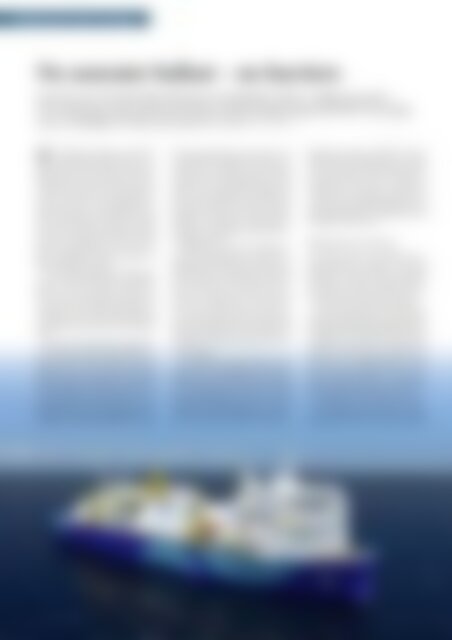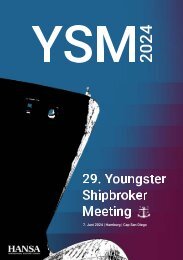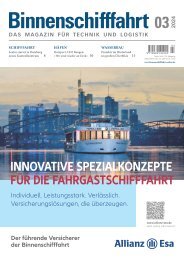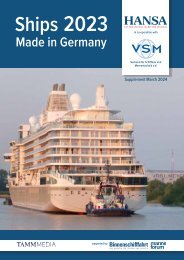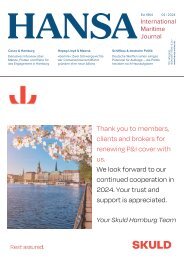HANSA 03-2018
Propeller Performance | Koalitionsvertrag | Jubiläum ZVDS | Robotik im Hafen | Ballastwasser Survey 2018 | Finanz- und Schifffahrtsstandort Nordamerika | Zeaborn & Rickmers
Propeller Performance | Koalitionsvertrag | Jubiläum ZVDS | Robotik im Hafen | Ballastwasser Survey 2018 | Finanz- und Schifffahrtsstandort Nordamerika | Zeaborn & Rickmers
Erfolgreiche ePaper selbst erstellen
Machen Sie aus Ihren PDF Publikationen ein blätterbares Flipbook mit unserer einzigartigen Google optimierten e-Paper Software.
Schiffstechnik | Ship Technology<br />
No seawater ballast – no barriers<br />
Later this year, Hyundai Mipo Dockyard is scheduled to deliver a highly innovative<br />
LNG bunkering vessel ordered by Bernhard Schulte Shipmanagement (BSM). The design<br />
rises to challenges of today and tomorrow, writes Felix Selzer<br />
The 7,600 m³ gas supply vessel (GSV)<br />
was ordered in late 2016 and is currently<br />
under construction with Lloyd’s<br />
Register (LR) class at HMD’s Ulsan site.<br />
»The project started as a TEN-T project<br />
as part of the EU’s LNG Masterplan in<br />
2012 to get LNG into the Rhine-Main-<br />
Danube waterway. We applied for one<br />
part of the program that was to supply<br />
LNG into Constanta in the Black Sea and<br />
to get it into the Danube where it would<br />
then be transhipped as far as Vienna,«<br />
John Eltringham, Project Director at<br />
BSM, explains to <strong>HANSA</strong>.<br />
To win the competition and get funding<br />
for a bunker and feeder vessel, BSM<br />
had to be very novel and innovative in<br />
every aspect of the ship. One of the many<br />
criteria was that the hull shape had to be<br />
suitable for rivers and canals including a<br />
very efficient bow and stern with reduced<br />
wake.<br />
The canal system posed also dimensional<br />
constraints. BSM needed 6,000m3 of<br />
LNG to make the ship viable and the design<br />
had to be very much like a standard<br />
ethylene carrier with type C tanks and aft<br />
accommodation. To get the forward view<br />
in line with SOLAS requirements, the accommodation<br />
was put in the front. »Our<br />
designers BMT Titron suggested that we<br />
looked at a traditional supply boat design<br />
with accommodation in front but to use<br />
a diesel electric propulsion system. If we<br />
used that we would have more benefits:<br />
With forward accommodation, forward<br />
engines, stern azimuthing thrusters and<br />
type C tanks midships, we could balance<br />
the ship much better and get the center<br />
of gravity much closer to the center of<br />
buoyancy. So we get away without seawater<br />
ballast,« Eltringham describes the development<br />
process.<br />
With the entry into force of IMO’s Ballast<br />
Water Management Convention in<br />
September 2017, ships constructed on or<br />
after this date are required to be fitted<br />
with a ballast water treatment system at<br />
delivery. The new GSV cleverly circumvents<br />
this requirement. The ship will<br />
only have a little quantity of fresh water<br />
on board which is only used for trim<br />
purposes and does not leave the ship. The<br />
concept from BMT Titron was taken over<br />
by HMD and developed further into a<br />
mature design.<br />
The shipyard extended the beam and<br />
increased the permanent ballast by a few<br />
hundred tons. The difference in draft is<br />
2.25 m from fully laden to ballast, the hull<br />
draft including cargo is only 2.85 m. »That<br />
is the good thing about LNG, it is not the<br />
heaviest cargo. The design just lends itself<br />
to the seawater ballast free concept,«<br />
Eltringham explains. HMD also had to<br />
address speed management by deadrise.<br />
Dead-rise is known to help improve<br />
the ship’s stability, which is critical to a<br />
»ballast-free« vessel, but it is also likely<br />
to deteriorate its speed performance. To<br />
counteract this, HMD developed a better<br />
performing dead-rise hull shape, tested<br />
through wet model tests.<br />
The gas process is the key<br />
Another key feature that enables the seawater<br />
ballast-free concept is the twin<br />
propulsion system with two azimuth<br />
thrusters. The smaller propeller diameter<br />
enables the vessel to achieve full immersion<br />
in all operational conditions.<br />
»Some of our innovation was just too innovative,«<br />
Eltringham says. »We wanted to<br />
use lightweight covering almost like modern<br />
high-rise building cladding, which is<br />
airtight and structurally very strong. But<br />
that was a step too far for HMD, so we<br />
went back to a traditional steel canopy<br />
deck. We are still under 1,000 t in a maximum<br />
condition of ballast – without seawater,<br />
which is great, because now we don’t<br />
need a ballast water treatment system.«<br />
The designers have also been innovative<br />
on the gas process, the power station<br />
arrangement and the transfer and other<br />
Source: BSM<br />
64 <strong>HANSA</strong> International Maritime Journal – 155. Jahrgang – <strong>2018</strong> – Nr. 3


